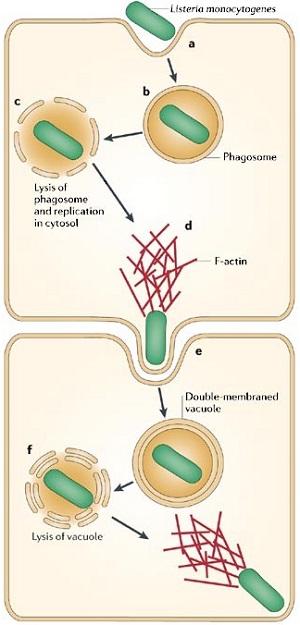Listeria monocytogenes - Clinical Manifestation, Pathogenesis
Clinical Manifestation/Symptoms of Listeria monocytogenes
Listeria monocytogenes cause listeriosis. Common manifestations/symptoms include fever, nausea, diarrhea, muscle ache, and lethargy. Infections are severe in immunocompromised individuals.
In pregnant women: mild flu-like symptoms, miscarriage, stillbirth, premature delivery, infected newborn. It spreads to the nervous system: headache, stiff neck, confusion, loss of balance, and convolution. In extreme cases, Pneumonia, meningitis, Meningoencephalitis, endocarditis, septicemia, and brain abscess occur.
The case fatality rate of Listeria monocytogenes is around 20-25%.

Fig: Listeria monocytogenes pathogenesis (Source: Nature)
Pathogenesis of Listeria monocytogenes
Hemolysin / Histolysin is the major virulence factor of Listeria monocytogenes. It is an extracellular, oxygen-labile, cholesterol-sensitive protein. It shows cross-reactivity with pneumolysin and streptolysin O.
The disease causes a variety of infections in the elderly, newborns, pregnant women, and immunocompromised. In non-pregnant women may be asymptomatic or cause mild febrile illness. Asymptomatic infection of the genital tract may lead to infertility.
Listeria monocytogenes may also cause occupational infection in poultry workers, butchers, and vets. In extreme cases: Pneumonia, meningitis, Meningoencephalitis, endocarditis, septicemia, and brain abscess.